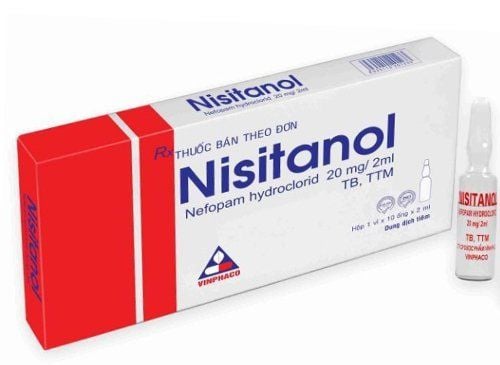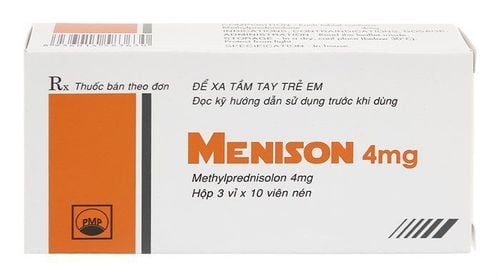This is an automatically translated article.
Tramabad is an intravenous drug, used in cases of moderate to severe pain. The active ingredient in the drug is Tramadol 100mg.
1. What is Tramabad?
Tramabad is a pain reliever, prepared in the form of a solution for injection: Intramuscular injection, intravenous injection, subcutaneous injection. The main active ingredient of Tramabad is Tramadol hydrochloride.
Tramadol is a synthetic opioid analgesic, with central analgesic effect and potential for addiction. Users will notice the effect of Tramabad right after the first 1 hour, the drug reaches its maximum effect after 2-3 hours of use.
When using Tramabad, users will not need to worry about affected heart function or respiratory depression like when using Morphine.
Tramabad is packaged as solution ampoules, each medicine box includes 5 ampoules of 2ml drug solution.
2. Indications and contraindications of the drug Tramabad
2.1. Indications Cases considered for indications for Tramabad pain relief include:
Moderate to severe pain. Pain after diagnosis. Pain after surgery. Consider in cases prone to constipation or respiratory disorders Cancer treatment. Acute musculoskeletal pain. Adjunctive therapy to NSAID therapy in chronic osteoarthritis 2.2. Contraindications Contraindicated to use Tramabad drug in case:
Hypersensitivity to the drug's components (Tramadol, Acid citrie monohydrate, sodium citrate) or Opiate agonists. Acute poisoning. Overdose of CNS depressants such as alcohol, beer, tranquilizers, sleeping pills, CNS depressants, opioid agonists or psychotropic drugs. Currently using or recently stopped (withdrawal time less than 15 days) of an MAO inhibitor. Patients with respiratory failure, severe liver failure. Children under 15 years old. Women who are breastfeeding. Epilepsy patients not controlled by treatment. Opioid addiction.
3. Dosage and how to use Tramabad
The dose of Tramabad and the number of times per day depends on the individual's response and pain status (acute or chronic pain).
3.1. Use Tramabad with acute pain Instructions for use: Intramuscular, slow intravenous injection (for about 2 - 3 minutes) or intravenous infusion. Note that the total dose of the drug should not exceed 400mg per day.
Postoperative pain relief:
Use 100mg for the first dose. After the first dose, every 10-20 minutes take 50mg. If necessary, in the first hour after surgery take a maximum of 250mg (including the first dose). After 4-6 hours, take 50-100mg. Note: The total daily dose should not exceed 600mg. 3.2. Using Tramabad with Chronic Pain Patients with chronic pain require long-term treatment. Therefore, it is necessary to treat pain relief first, specifically: Use a low dose of Tramabad and then increase it gradually to find the right dose for the patient.
Starting point: Use 25mg/day. After 3 days, increase by 50mg per day, increasing to a total dose of 200mg/day or more. After choosing a suitable dose: Take a dose of 50-100mg/time, every 4-6 hours, the total daily dose should not exceed 400mg. Note to use Tramabad for patients with impaired liver and kidney function: Reduce the dose and prolong the time between 2 doses of the drug, specifically as follows:
For people with impaired renal function (creatinine clearance). <30ml/min): The total dose is less than 200mg, the interval between 2 doses is 12 hours. For patients with more severe renal impairment (creatinine clearance < 10ml/min): Do not use. For people with severe liver failure: Each dose of 50ml, the interval between 2 doses is 12 hours. People on hemodialysis: Use regularly on the day of hemodialysis. Elderly (65 - 75 years old): The total dose is less than 300mg/day, divided into several doses.
4. Notes when using Tramabad
Tramabad users need to be especially aware of a number of problems, including: Convulsions, suicide and Serotonin syndrome :
Convulsions: The risk of convulsions is increased if the recommended dose is exceeded. At the same time, Tramabad also increased the risk of seizures in patients using tricyclic antidepressants or tricyclic active ingredients, SSRIs. Suicide: Several reports suggest an association in mortality between Tramabad use and patients with mood disorders, suicidal ideation, and stimulant/suppressant abuse. Serotonin syndrome: Serotonin syndrome can be life-threatening when Tramabad is used, especially when used with other Serotonergic drugs.
5. Interaction of Tramabad with other drugs
Some of the drugs that interact with Tramabad include:
MAO/MAOI inhibitors. Drugs with CNS depressant effects, including alcohol and anesthetics: Increased CNS depression. Carbamazebin: Decreased analgesic effect Quinidine: Decreased metabolism and increased analgesic effect. To avoid interactions, before being prescribed Tramabad, the patient should inform the doctor about the drugs they are using, including functional foods. The doctor will base on that to prescribe the appropriate Tramabad.
To use Tramabad safely and effectively for your own condition, users should consult with a doctor, absolutely do not use without a doctor's prescription.
Please dial HOTLINE for more information or register for an appointment HERE. Download MyVinmec app to make appointments faster and to manage your bookings easily.













